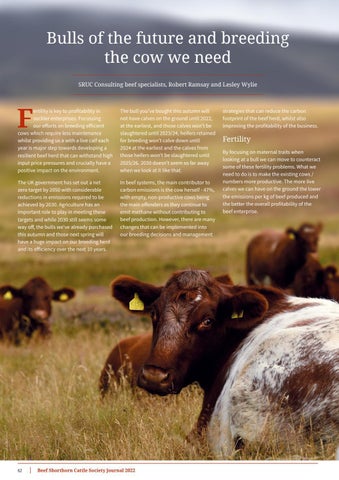Bulls of the future and breeding the cow we need SRUC Consulting beef specialists, Robert Ramsay and Lesley Wylie
F
ertility is key to profitability in suckler enterprises. Focussing our efforts on breeding efficient cows which require less maintenance whilst providing us a with a live calf each year is major step towards developing a resilient beef herd that can withstand high input price pressures and crucially have a positive impact on the environment.
The bull you’ve bought this autumn will not have calves on the ground until 2022, at the earliest, and those calves won’t be slaughtered until 2023/24, heifers retained for breeding won’t calve down until 2024 at the earliest and the calves from those heifers won’t be slaughtered until 2025/26. 2030 doesn’t seem so far away when we look at it like that.
The UK government has set out a net zero target by 2050 with considerable reductions in emissions required to be achieved by 2030. Agriculture has an important role to play in meeting these targets and while 2030 still seems some way off, the bulls we’ve already purchased this autumn and those next spring will have a huge impact on our breeding herd and its efficiency over the next 10 years.
In beef systems, the main contributor to carbon emissions is the cow herself - 47%, with empty, non-productive cows being the main offenders as they continue to emit methane without contributing to beef production. However, there are many changes that can be implemented into our breeding decisions and management
62
Beef Shorthorn Cattle Society Journal 2022
strategies that can reduce the carbon footprint of the beef herd, whilst also improving the profitability of the business.
Fertility By focusing on maternal traits when looking at a bull we can move to counteract some of these fertility problems. What we need to do is to make the existing cows / numbers more productive. The more live calves we can have on the ground the lower the emissions per kg of beef produced and the better the overall profitability of the beef enterprise.
































